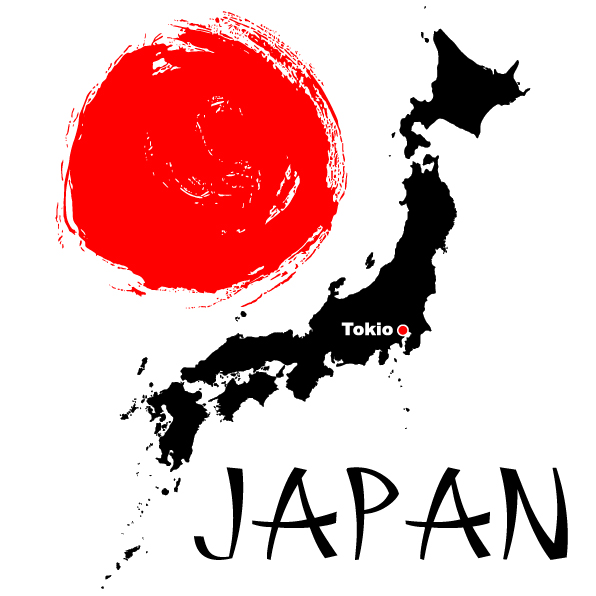

JAPAN’S NATIONAL SYMBOLS FLAG, ANTHEM AND EMBLEM
Japanese flag
The history of the Japanese flag dates back 1000 years, when various banners were used as symbols of power and as identification signs of the fighting armies. The prototype of the Japanese flag was created in the Heian period and it was connected with the legend about the fist Japanese emperor – Jimmu. Legend has it that the emperor with his army had a great victory with the support of the sun, which illuminated him from the back and blinded the opponents. The red circle against the white background was to symbolise the rising sun, which takes care of the whole nation. The faith in the incredible power of the sun was cultivated by medieval leaders, who put its symbols behind the backs of a fighting army. Choosing a bright star for its national symbol, the Japanese alluded directly to the protective nature of the sun.
Hinomaru – official flag of Japan
It became necessary to formalise the national symbol when Japan opened up to the world after years of isolation and started to become a prominent international player. Hinomaru, as the Japanese flag was officially called, became a mandatory item on Japanese ships and a permanent element of the Japanese national consciousness.
But there was a moment in the history of Japan when the fate of the red shield against the white background was uncertain. During the World War II, the symbol invoked strong negative associations with the imperialist and military power of Japan so discussions on whether or not it should be changed continued for a long time after the war. Hinomaru was not officially recognised as a Japanese national symbol until 1999, when the National Flag and Anthem Act was approved. The day when the Act was signed (13 August) was named the National Flag Day.
There are many simultaneous and interweaving interpretations of Japan’s flag. A more obvious one is comparing the emperor to the bright sun protecting the whole Japan. The sun symbolism is also connected with the geographic location of Japan – the Land of the Rising Sun. The colours of the flag may be interpreted as a wish for a happy and innocent life under the watchful eye of Shinto gods. In Shinto, red is the colour of the cleansing fire, sun and life. White, on the other hand, symbolises virgin-like purity.
The emblem of Japan
Japan does not have an official national emblem, which makes it a true exception among the countries of the world. The reasons for lack of a national symbol that the Occident culture considers to be of great importance should be sought in the years of isolation of the insular country. The traditions typical of medieval European knights, where coats of arms played a significant role, had no chances of reaching Japan.
In the Country of Cherry Blossoms, the formal sign of the actually reigning dynasty had a similar function. It is currently the coat of arms of emperor Kiku-no Gomon – a golden chrysanthemum whose petals symbolise happiness and longevity. Chrysanthemums, the Chinese flowers of happiness and wisdom, caught the interest of emperor Go-Toba as early as in the 12th century as he decorated his personal seal with floral motifs. Subsequent rulers continued his appreciation of chrysanthemum, which in time became a sanctified symbol of the reining dynasty. Still, it was not until the end of the 19th century that it officially gained that status.
During World War II, chrysanthemum was placed on warships and it was a common symbol of the Empire of Japan. Today, the Japanese coat of arms is used by the diplomatic representatives of Japan and in foreign Japanese institutions.
Japan’s national anthem
Kimigayo has been Japan’s official anthem since 1888. Just as in the case of the flag, the music symbol of the country was formally established because Japan opened up to the foreign world. An anonymous 10th century tanka (short form of Japanese poetry) was chosen for the lyrics. As a result, Japan has the world’s oldest anthem lyrics, even if they were approved as one of the last! Tankas in principle include a plethora of emotional expressions, epithets and metaphors. Which is why proper interpretation of the words is so important. It is usually understood as a general praise of the emperor and as a wish that he always stayed in good health.
Curiously enough, the idea to create the anthem based on a medieval text did not come from any Japanese enthusiast of old poetry but from an Englishman John William Fenton. He was the first one to undertake writing the music for the poem, which was delivered to him by advocates of Japanese reforms. But Fenton’s proposal was rejected, and the new version was developed by Hiromori Hayashi – the musician of the imperial court. Ultimately, after subsequent changes made by Franz Eckert, the anthem was presented to the public in 1880. The official creation date is 1888, when the anthem was sent to the representatives of all the countries that had diplomatic relations with Japan. In 1999, its functions were confirmed by the constitutional National Flag and Anthem Act.
Characteristic symbols of Japan
When asked by the national symbols of their country, every European quickly lists the flag, the anthem and the emblem. It turns out that the national symbolism is not that obvious for the Japanese, who needed neither an emblem nor an anthem until the end of the samurai era. Though short, the history of Japan’s national symbols says a lot about the history of the whole nation, so different from the Western models, and it offers more profound understanding of the specificities of Japanese culture.














